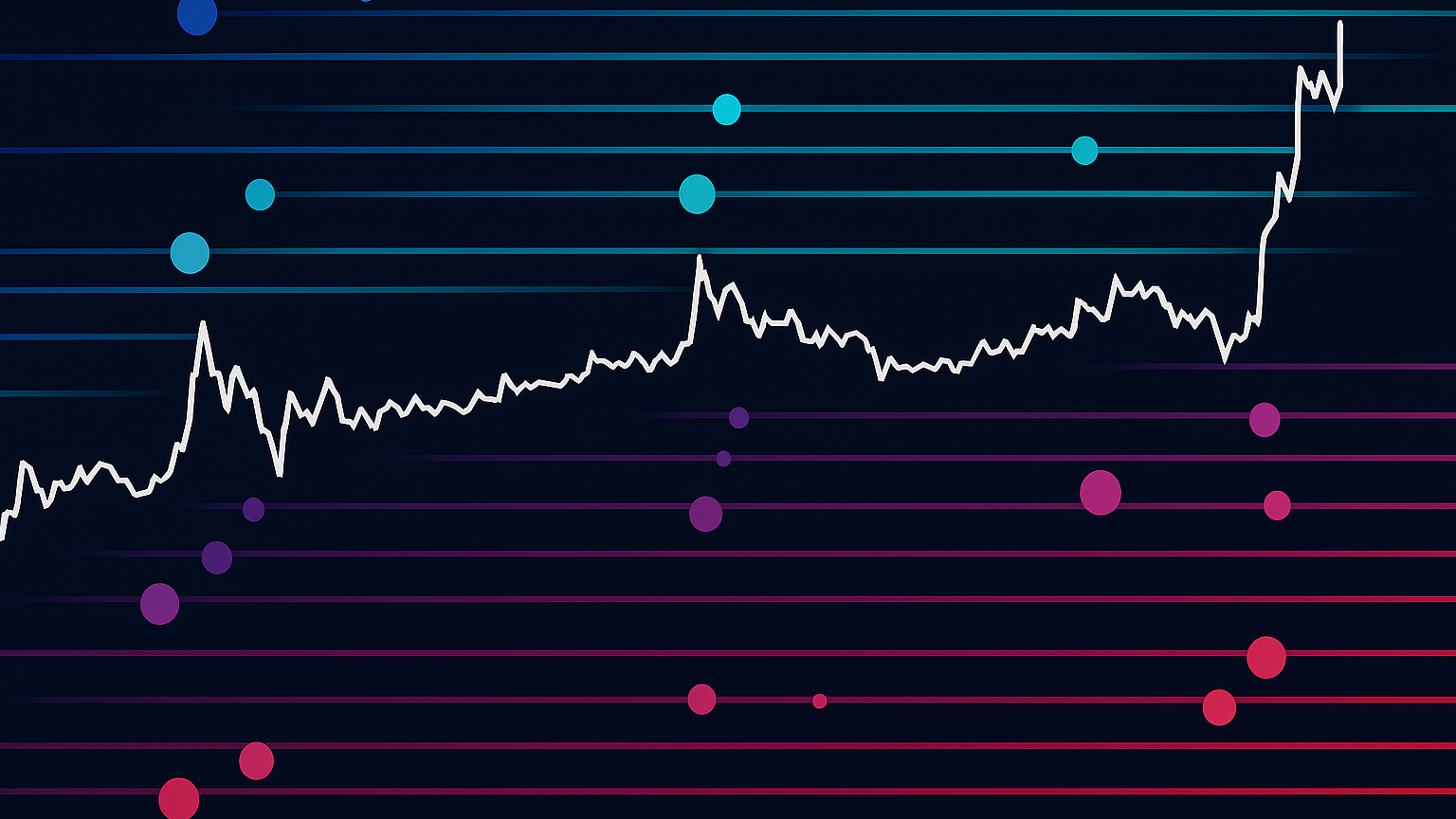Learn how to effectively trade by riding market trends, using patterns and tools to maximize profits while managing risk.
Want to make better trading decisions? Focus on riding existing market trends instead of chasing reversals. Trend continuation trading simplifies your strategy by leveraging the market's natural momentum. Here's what you'll learn:
- Key Patterns: Flags, pennants, triangles, and rectangles signal trend pauses before continuation.
- Confirmation Tools: Use moving averages (10, 50, 200-day) and volume analysis to validate trends.
- Risk Management: Set clear stop-losses, profit targets, and adjust for volatility.
- Smart Tools: LuxAlgo provides hundreds of free indicators in its Library, three exclusive toolkits on TradingView—Price Action Concepts, Signals & Overlays, Oscillator Matrix—and an AI Backtesting Assistant for creating strategies automatically.
Continuation Patterns – The Symmetrical Triangle and Flag
How to Spot Trend Patterns
Recognizing trend continuation patterns involves observing their shapes and using technical tools. Let’s break down the key patterns that indicate a trend is likely to continue.
Main Pattern Types
Trend patterns often take on specific shapes, signaling a brief pause before the trend resumes. Some of the most common patterns include:
| Pattern Type | Characteristics | Trading Implications |
|---|---|---|
| Flags | Parallel lines showing short-term consolidation | Often lead to sharp breakouts |
| Pennants | Small triangle shapes with converging lines | Signal compression before continuation |
| Triangles | Can be ascending, descending, or symmetrical | Suggest longer-term consolidation |
| Rectangles | Horizontal support and resistance levels | Indicate sideways movement before continuation |
Trend Confirmation Tools
Moving averages are essential for confirming both the direction and strength of a trend. Different time periods help analyze various horizons:
- Long-term: 200-day moving average
- Medium-term: 50-day moving average
- Short-term: 10- or 20-day moving average
"The 10-day exponential moving average (EMA) is my favorite indicator to determine the major trend. I call this 'red light, green light' because it is imperative in trading to remain on the correct side of a moving average to give yourself the best probability of success. When you are trading above the 10-day, you have the green light, the market is in positive mode and you should be thinking buy. Conversely, trading below the average is a red light. The market is in a negative mode and you should be thinking sell." – Marty Schwartz
To strengthen your analysis, combine moving averages with indicators like RSI and MACD. For example, during an uptrend, prices staying above key moving averages confirm the trend's momentum; during a downtrend, prices remaining below these averages reinforce its strength. Volume analysis provides additional confirmation.
Volume Analysis
Volume plays a critical role in validating trend continuations. Strong trends are often accompanied by increasing volume during price moves, while weaker trends show declining volume.
Key volume signals to watch:
- Breakout Volume: A breakout with volume significantly above the recent average confirms momentum.
- Pattern Development: Stable volume during pattern formation adds reliability.
- Trend Strength: Rising volume in the trend's direction reflects solid momentum.
Breakouts with noticeably higher trading volume tend to be more reliable, signaling stronger trader confidence and support continued price movement.
Trading Trend Continuations
To profit from trend continuations, you need precise entries, smart exits, and solid risk management. These methods rely on well-established technical patterns and confirmation tools to refine your trading strategy.
When to Enter and Exit
Enter trades when there’s a clear breakout above a pattern, ideally accompanied by increased volume to reduce the risk of false signals. Define both entry and exit rules in advance.
| Exit Type | How to Use It | Why It Matters |
|---|---|---|
| Profit Target | Based on the pattern’s range | Secures planned profits |
| Stop Loss | Set below key support or resistance | Protects against large losses |
| Trailing Stop | Adjust using ATR or moving averages | Safeguards gains as the trade moves in your favor |
Risk Control Methods
Keep your account risk to 1% or less per trade. Here are some effective techniques:
- Position Sizing: Calculate based on your risk tolerance and the trade’s technical stop level.
- Hard Stops: Use fixed stop-loss orders instead of mental stops to remove emotional decision-making.
- Daily Loss Limits: Set limits to protect yourself from unusual market conditions.
- Breakeven Stops: Shift your stop-loss to breakeven once your profit matches the initial risk.
Adjusting for Market Conditions
Market volatility can impact your trades, so it’s essential to adjust when conditions change. Here’s how:
- Smaller Positions: Reduce position sizes during high volatility.
- Wider Stops: Allow for larger price swings but adjust position sizes to maintain consistent risk.
- Increased Cash Reserves: Hold more cash during turbulent periods to buffer against sudden moves.
Tools for Trend Analysis
Modern solutions make it easier to spot and act on market trends. They build on the strategies we've already discussed, helping traders identify and confirm trends faster.
LuxAlgo on TradingView

On TradingView, LuxAlgo’s Price Action Concepts toolkit automates market-structure detection and support & resistance levels; Signals & Overlays offers configurable signal modes and alerts; Oscillator Matrix provides trend-following and divergence indicators—all working together for a complete trend-analysis framework.
"With our all-in-one indicator toolkits, you’ll have full workflows for price action trading, trend following, and reversal identification in one place. Say goodbye to using tons of confusing tools."
AI in Trend Analysis
Artificial intelligence brings efficiency to trend analysis. LuxAlgo’s AI Backtesting Assistant on LuxAlgo.com/backtesting can generate and evaluate strategies across 93+ tickers, using millions of historical data points.
AI enhances your process by:
- Pattern Recognition: Identifying complex setups via neural networks.
- Automated Screening: Scanning multiple markets for high-probability continuations.
- Risk Assessment: Evaluating drawdowns and win rates across scenarios.
Platform Integration
LuxAlgo’s indicator toolkits are built for TradingView, delivering:
- Real-time charts with up to 8 synchronized views
- 100+ technical indicators for confirmation
- Custom workspaces supporting multi-timeframe and multi-indicator layouts
Common Trend Trading Mistakes
Consolidation vs. Reversal
Exiting too early during consolidation can cause missed gains. To differentiate:
| Pattern Type | Key Characteristics | Suggested Action |
|---|---|---|
| Consolidation | Flag patterns, sideways movement, low volume | Wait for a breakout confirmed by strong volume |
| Reversal | Price moves against the trend, high volume | Exit if the reversal is clearly confirmed |
| False Breakout | Small breach with low volume | Wait for a retest before acting |
Trading Too Much
Overtrading can erode profits. Manage it by:
- Setting daily or weekly trade limits
- Sticking to a fixed risk per trade (e.g., 2% of account)
- Focusing on high-probability setups aligned with the broader trend
- Regularly reviewing trade frequency and outcomes
Missing Key Price Levels
Identify major support and resistance zones—such as prior highs/lows, round numbers, and high-volume areas—using multi-timeframe analysis. Confirm these levels with overlapping indicator signals and volume spikes. Place stops just beyond these zones to protect against sudden reversals.
Conclusion
Main Points
Effective trend trading hinges on pattern recognition, volume confirmation, and disciplined risk control. LuxAlgo’s Price Action Concepts toolkit automates structure detection and breakout confirmation, while Signals & Overlays and Oscillator Matrix complete a comprehensive setup.
| Component | Purpose | Implementation |
|---|---|---|
| Pattern Recognition | Spot consolidation | Flags, pennants, triangles via indicators |
| Volume Confirmation | Validate breakouts | Check for rising volume on moves |
| Risk Management | Protect capital | Position sizing, stop orders near key levels |
| Market Context | Align with trends | Avoid trading in extreme volatility |
Getting Started
- Choose a Plan
Essential ($24.99/mo) for pattern detection and volume tools; upgrade to Premium ($39.99/mo) or Ultimate ($59.99/mo) for full indicator and AI Backtesting access. - Practice with Examples
Analyze a real breakout—like Tesla’s 2023 bullish pennant, which broke out at $200 and rallied to $291. - Implement Risk Controls
Adjust size, set hard stops just outside support or resistance, and avoid trading in the final 15 minutes of each hour.






